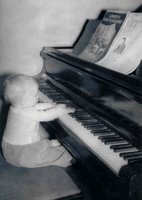 Since I’ve been writing here about the music I’m composing, I thought I’d take a few posts to write about my “musical language.” Yeah, there’s a Music Geek Alert here – caution: musical notation ahead – but I don’t have recordings I can excerpt to post on-line, an in-tune piano I can record sound-bytes on and I’m still trying to figure out the new music-writing software I just downloaded. So if you don’t read music, my apologies; if you have to drag your computer over to your piano to play them, sorry for that inconvenience, too.
Since I’ve been writing here about the music I’m composing, I thought I’d take a few posts to write about my “musical language.” Yeah, there’s a Music Geek Alert here – caution: musical notation ahead – but I don’t have recordings I can excerpt to post on-line, an in-tune piano I can record sound-bytes on and I’m still trying to figure out the new music-writing software I just downloaded. So if you don’t read music, my apologies; if you have to drag your computer over to your piano to play them, sorry for that inconvenience, too.First of all, my music is not “serial.” I don’t even like to call it “atonal” even though it uses all twelve pitches of the chromatic scale and forms chords and melodic lines that are full of major 7ths and tritones.
In a traditional tonal context, my music would be described as “dissonant” because it uses a lot of elements beyond the normal scope of the major-minor Common Practice system even as it’s used today. But in a serial context, it would sound “elementary” because it doesn’t go far enough in organizing the pitches into specific orders, combinatorial permutations (or at least consciously) or other technical details that are part of the technique.
After years of reading about composers abandoning serial music for tonality, I was least impressed by the observation that the system was too intellectualized and that the music was too devoid of anything remotely emotional. Coming from a composer, this tells me the composer is letting the system control the music. If the composer were controlling the system, the music would do whatever he or she wanted it to. You can be controlled by tonality just as much as you can be controlled by serialism, but there are certain ground-rules to each system and just as composers in the past have adapted and broken those rules to create the way they wanted to, a composer writing today should have the flexibility to adapt any other principals according to one’s own individual tastes. That’s what creates the composer’s voice or style which develops gradually over time, absorbing lots of different voices and experiences along the way.
But today we’re expected to be “original” from the beginning and any experimenting is dismissed as “imitation” before a young composer can even write enough music to allow those natural fingerprints to float to the surface.
It’s not like I’ve exactly chosen to “take my time.” After the Mother of All Writing Blocks, I’ve been struggling gradually to get back to that surface and see what’s left. Now I’m doing the work I didn’t feel like doing 20 years ago. It’s a slow process and it’s part of what this blog is all about, anyway.
Even though I never went so far as serialism, myself – more because I’m not intellectual enough for IT rather than vice-versa – I found I was missing things I could do if I were writing tonal music. Without a tonal context, things like sequences and modulations, deceptive resolutions and the frisson on a Neopolitan chord were lost to me. But I didn’t feel like I wanted to chuck it all and go back to writing like Schubert. I wanted to turn that strand-of-thought into the anti-thesis of my all-chromatic style’s thesis to come up with some kind of dialectic synthesis.
There must be a way, some common ground that would allow me to do this. And I thought perhaps if I go back to the pre-serial style of presumably “unorganized” atonality, I might find it. This would primarily be the music that composers like Schoenberg, Stravinsky, Scriabin and others were composing in the first two decades of the 1900s.
(Term clarification: atonal means "without reference to a tonal center" like C Major or D Minor; serial music is basically atonal but not all atonal music is serial.)
When I was still teaching at the University of Connecticut back in the late-70s when academic serialism still ruled the roost, I bought a copy of Allen Forte’s “Structure of Atonal Music.” Once I figured out his system of analyzing this music was not a serial one but only adapting serial methods and terminology (and this took a while, luddite that I am on more levels than the purely computorial), I became lost in the extreme mathematics of his approach. (I become easily lost in the extreme mathematics of any theoretical approach, I’m afraid...)
I began using some of his approach to unlock some new sounds and new ways of creating them, but not much of it: the results were very elementary, though a piano piece like “Poetries” which received its premiere at a Carnegie Recital Hall program by Rebecca Labreque in 1979 and which Galen Deibler performed at Susquehanna University in 2004, may not sound so elementary to the player or the listener.
To a full-fledged serialist, it would be comparable to taking the first few chapters of a traditional tonal harmony text book without getting into the refinements of modulation or even using secondary chords. (Come to think of it, that's comparable to what I did when I was 13 years old and just beginning to compose, before I’d had any theory lessons and didn’t know you could modulate, much less how to.)
Then, after more than a decade of total dormancy, I started writing again, quite unexpectedly, waking up at 50 and realizing I still wanted to be a composer when I grew up.
For some reason, I went back to Forte’s book and even though I still couldn’t make a lot of sense out of the more mathematical aspects of the second half of the book, I began realizing more about his method and how it could be applied to other composers but more importantly to myself. It is not, I need to point out, the system that those composers used: this is a theorist’s approach to how their music is organized but whether it follows the logic of the composers themselves or not is not the point. Whether Stravinsky and Schoenberg had “methods” to their seeming madness between 1911 and 1921, we’ll never know, but in examining their music, this is what Forte found and how he chose to describe it..
It's awkward to use old terms because that terminology is fraught with old definitions: "chord" brings with it the baggage of major or minor chords and the way they function from traditional tonal language, so this gives rise to more complex-sounding jargon like “pitch aggregates” or whatever.
So, Forte groups pitches together in various combinations and gives them codes to describe their content. While some listeners hearing Schubert might say “wow, listen to that Neopolitan 6th of V, there,” no one is going to say “wow, listen to that change to 6-Z47, there!” It’s an analytic tool and besides, everything has to be called something and it just makes more sense than calling them Fred, Betty, Ethel or George.
You can group six notes of the 12-note scale into a unit called a hexachord. If you take the “other” six notes left in the twelve-note chromatic scale, you come up with that hexchord’s complement. In that way, you've got all 12 notes but these pitches do not form a “12-tone row” in the traditional Schoenberg sense, where they maintain a specified order. Here, you can use them in any order you wish. You’re not even restricted to just those pitches, basically, since you can move from one starting pitch level (just as you can take a C Major scale and move it to F Major) or from one hexachord to another similar or related one. You can divide them to find various sub-groups and combinations.
At any rate, I realized that one of his hexachords which I particularly liked for some reason (see Example 1) could be subdivided into two of my favorite 3-note chords (it’s not a triad which is a chord built on thirds in the tonal system) which I used at the opening of “Poetries” plus another 3-note chord like it (see Example 1a). But those six notes could also be subdivided to come up with traditional major and minor triads, in this case a pair of triads a tritone apart (see Example 1b).

You can do the same thing with “the other six notes” or the complement hexachord (see Ex.2). This produces the same chords as Ex.1(a1) but transposed to different pitches and then inverted (Ex.2a) as well as major and minor triads a whole-step apart (Ex.2b).
 This gave me an idea.
This gave me an idea.If I could start out with the non-traditional “atonal-sounding” trichords like Ex.1&2(a) and then move gradually to using the traditional tonal-sounding triads in Ex.1&2(b), I could use the same hexachord as my structural pitch source (the equivalent of saying “C Major Scale”) but write music that would sound, gradually, less and less “dissonant.”
What I liked most, however, was that even though these triads sounded like tonal chords, they did not move in a tonal context: their roots moved in seconds and tritones, not seconds, fourths and fifths which form the backbone of Classical Era tonal harmony. In fact, if you take a C Major progression like iii-IV-V-I (see Ex.3) where the V-I is a primary relationship and the iii-IV and IV-V are secondary relationships, the IV-to-V is a whole step just like my first set, so if I consider the “secondary relationship” in this succession to be the chords of Ex.2b, then my primary relationship would be the tritone motion between the F-sharp Minor and the C Major triads of Ex.1b. This becomes Ex.3a.
If I wanted to go from a dissonant form of the secondary chords, I could use Ex.2a to create a certain amount of tension in this voicing, but resolve it to the triads of Ex.1b – which becomes Ex.3b. They’re all the same pitches, just re-arranged.
 So, if that’s the equivalent of Dominant to Tonic motion in harmony, I could say C is my tonal center and F-sharp is my dominant. And suddenly I realized I not only had a chord “progression” on my hands (rather than just a “succession” of chords), something that could now move with the same inevitable sense of harmonic tension one senses in tonal music, I also had a substitute for the idea of tonal centers in traditional tonality.
So, if that’s the equivalent of Dominant to Tonic motion in harmony, I could say C is my tonal center and F-sharp is my dominant. And suddenly I realized I not only had a chord “progression” on my hands (rather than just a “succession” of chords), something that could now move with the same inevitable sense of harmonic tension one senses in tonal music, I also had a substitute for the idea of tonal centers in traditional tonality.How do I establish that sense in the listener’s ear? By repetition of the formulas and maintaining it logically in the course of the piece. Just like composers did 200 years ago.
And that was how I got back into composing again.
Next: how this works in the pieces for violin and piano I’m writing now: stay tuned.
*** ***** ******** ***** ***
Image credit (from the private collection of Dr. Dick): the composer assisted by muse Roquefort, though it was actually taken during a spurt of creativity 20 years ago...
Thanks to John Clare for setting me onto Finale for their free music-writing "note pad" software which I downloaded last night and have just started trying to figure out. No, I'm not going to be doing full scores with this, but it works great for musical examples on the blog. Unfortunately, I can't get them to "play" for you just by the click of a coloratura mouse... sorry about that.







